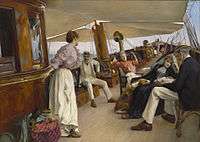Julius LeBlanc Stewart

Julius LeBlanc Stewart (September 6, 1855, Philadelphia, Pennsylvania — January 5, 1919, Paris, France), was an American artist who spent his career in Paris. A contemporary of fellow expatriate painter John Singer Sargent, Stewart was nicknamed "the Parisian from Philadelphia".[1]
His father, the sugar millionaire William Hood Stewart, moved the family from Philadelphia, Pennsylvania to Paris in 1865, and became a distinguished art collector and an early patron of Marià Fortuny and the Barbizon artists. Julius studied under Eduardo Zamacois as a teenager, under Jean-Léon Gérôme at the École des Beaux-Arts, and later was a pupil of Raymondo de Madrazo.
Stewart's family wealth enabled him to live a lush expatriate life and paint what he pleased, often large-scaled group portraits. The first of these, After the Wedding (Drexel University Art Collection, 1880), showed the artist's brother Charles and his bride Mae, daughter of financier Anthony J. Drexel, leaving for their honeymoon. Subsequent group portraits depicted his friends — including actresses, celebrities and aristocrats — often with a self-portrait somewhere in the crowd.
He exhibited regularly at the Paris Salon from 1878 into the early 20th century, and helped organize the "Americans in Paris" section of the 1894 Salon. The Baptism (Los Angeles County Museum of Art, 1892), which reportedly depicts a gathering of the Vanderbilt family, was shown at the 1893 Chicago World's Columbian Exposition, and received acclaim at the 1895 Berlin International Exposition.
He painted a series of sailing pictures aboard James Gordon Bennett, Jr.'s yacht Namouna. The most accomplished of these, On the Yacht "Namouna", Venice (Wadsworth Atheneum, 1890), showed a sailing party on deck and included a portrait of the actress Lillie Langtry. Another, Yachting on the Mediterranean (1896), set a record price for the artist, selling in 2005 for US$2.3 million.[2]
Late in life, he turned to religious subjects, but Stewart is best remembered for his Belle Époque society portraits and sensuous nudes.
Selected works

- Horse Trough on a Cuban Plantation (1876), Pennsylvania Academy of the Fine Arts, Philadelphia, Pennsylvania
- After the Wedding (aka Parisian Wedding) (1880), Drexel University Museum, Philadelphia, Pennsylvania[3]
- Five O'Clock Tea (1884), Iris & B. Gerald Cantor collection, New York City[4]
- The Hunt Ball (1885), Essex Club, Newark, New Jersey. Includes portraits of the actress Lillie Langtry and Baron Rothschild.[5]
- On the Yacht "Namouna", Venice (1890), Wadsworth Atheneum, Hartford, Connecticut
- The Baptism (1892), Los Angeles County Museum of Art[6] Reportedly, this shows a gathering of the Vanderbilt family.
- Yachting on the Mediterranean (1896), private collection
- The Goldsmith Ladies ... in a Peugeot (1897), Musée du Château de Compiègne, France
- La Clairiere (The Glade) (1900), Detroit Institute of Arts
- Les Nymphes de Nysa (The Nymphs of Nysa) (1900), Musée d'Orsay, Paris[7]
- Portrait of Mrs. Francis Stanton Blake (1908), Walters Art Museum, Baltimore, Maryland[8]
 The Ball
The Ball_1907.jpg) View Of Venice (The Dogana) (1907)
View Of Venice (The Dogana) (1907) Young Beauty In A White Dress
Young Beauty In A White Dress Nymphs Hunting or Hunting (1898)
Nymphs Hunting or Hunting (1898) Disappointment: Portrait of Sarah Bernhardt (1882).
Disappointment: Portrait of Sarah Bernhardt (1882). Self-portrait (1886)
Self-portrait (1886) On the Yacht "Namouna", Venice (1890), Wadsworth Atheneum. Lillie Langtry is the seated woman, right.
On the Yacht "Namouna", Venice (1890), Wadsworth Atheneum. Lillie Langtry is the seated woman, right. The Baptism (1892), Los Angeles County Museum of Art.
The Baptism (1892), Los Angeles County Museum of Art. Rédemption (1895), Musée d'Art et d'Industrie, Roubaix, France.
Rédemption (1895), Musée d'Art et d'Industrie, Roubaix, France. The Goldsmith Ladies ... in a Peugeot (1897), Musée du Château de Compiègne, France
The Goldsmith Ladies ... in a Peugeot (1897), Musée du Château de Compiègne, France La Clairiere (aka The Glade) (1900), Detroit Institute of Art
La Clairiere (aka The Glade) (1900), Detroit Institute of Art Portrait of Mrs. Francis Stanton Blake (1908), Walters Art Museum
Portrait of Mrs. Francis Stanton Blake (1908), Walters Art Museum
References
- Ulrich W. Hiesinger, Julius LeBlanc Stewart, American Painter of the Belle Epoque, exhibition catalogue, Vance Jordan Fine Art, Inc. (New York 1998)
- ↑ D. Dodge Thompson, "Julius L. Stewart, a 'Parisian from Philadelphia'", The Magazine Antiques (November 1986), pp. 1046-58.
- ↑ Christie?s. "Julius LeBlanc Stewart (1855-1919)". christies.com.
- ↑ http://www.drexel.edu/univrel/drexelcollection/wedding.html
- ↑ "Five O'Clock Tea by Julius LeBlancStewart".
- ↑ http://www.ricci-art.net/img008/333.jpg
- ↑ "Page not found". lacma.org.
- ↑ "Musée d'Orsay: non_traduit". musee-orsay.fr. 16 February 2009.
- ↑ "Portrait of Mrs. Francis Stanton Blake". The Walters Art Museum · Works of Art.
 This article incorporates text from a publication now in the public domain: Chisholm, Hugh, ed. (1911). "article name needed". Encyclopædia Britannica (11th ed.). Cambridge University Press.
This article incorporates text from a publication now in the public domain: Chisholm, Hugh, ed. (1911). "article name needed". Encyclopædia Britannica (11th ed.). Cambridge University Press.
External links
| Wikimedia Commons has media related to Julius LeBlanc Stewart. |